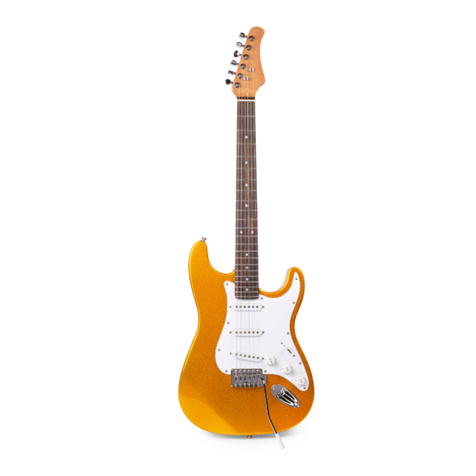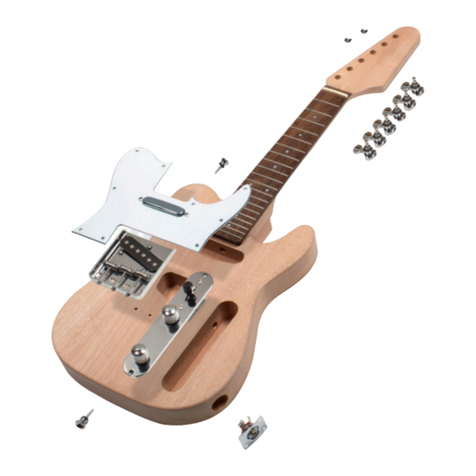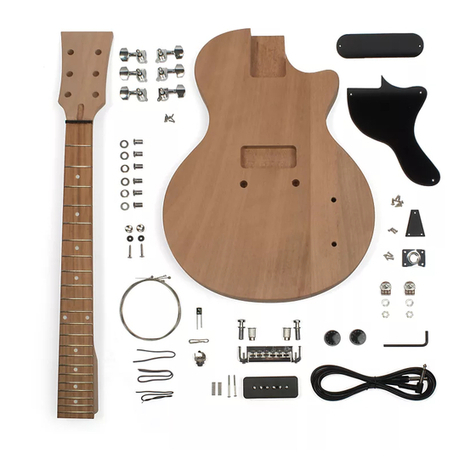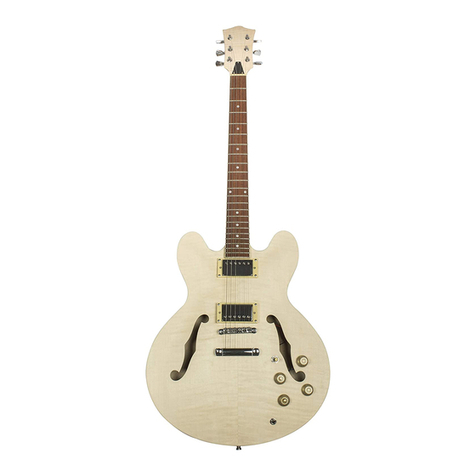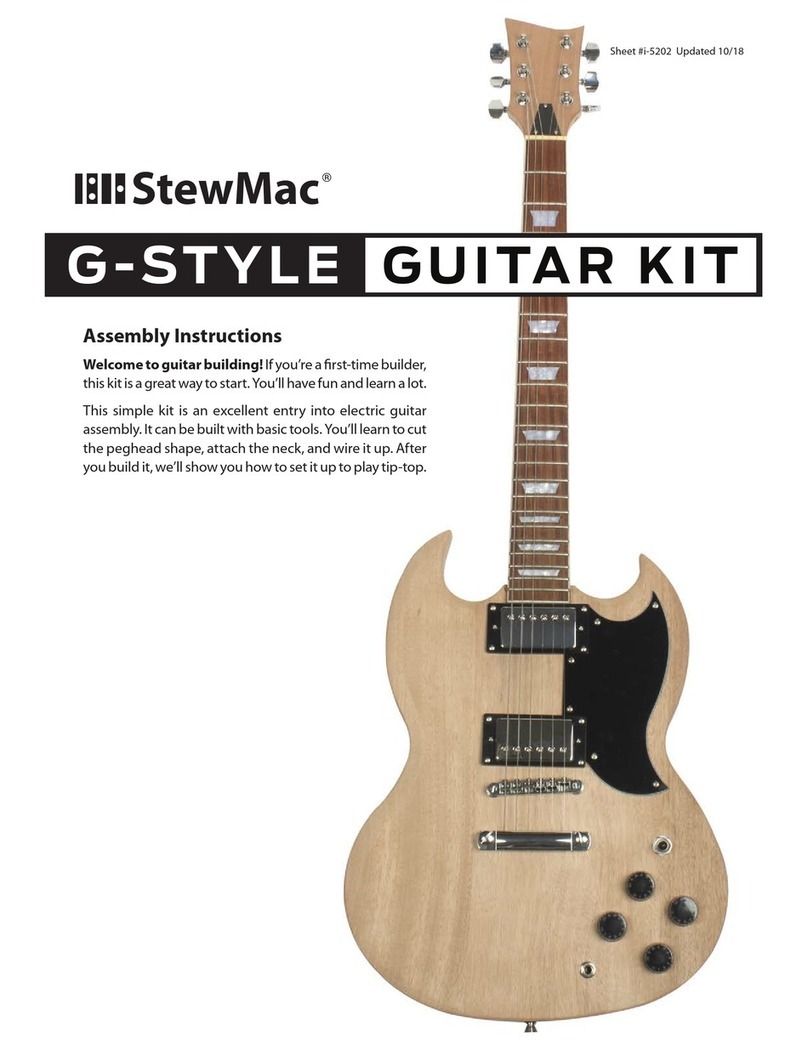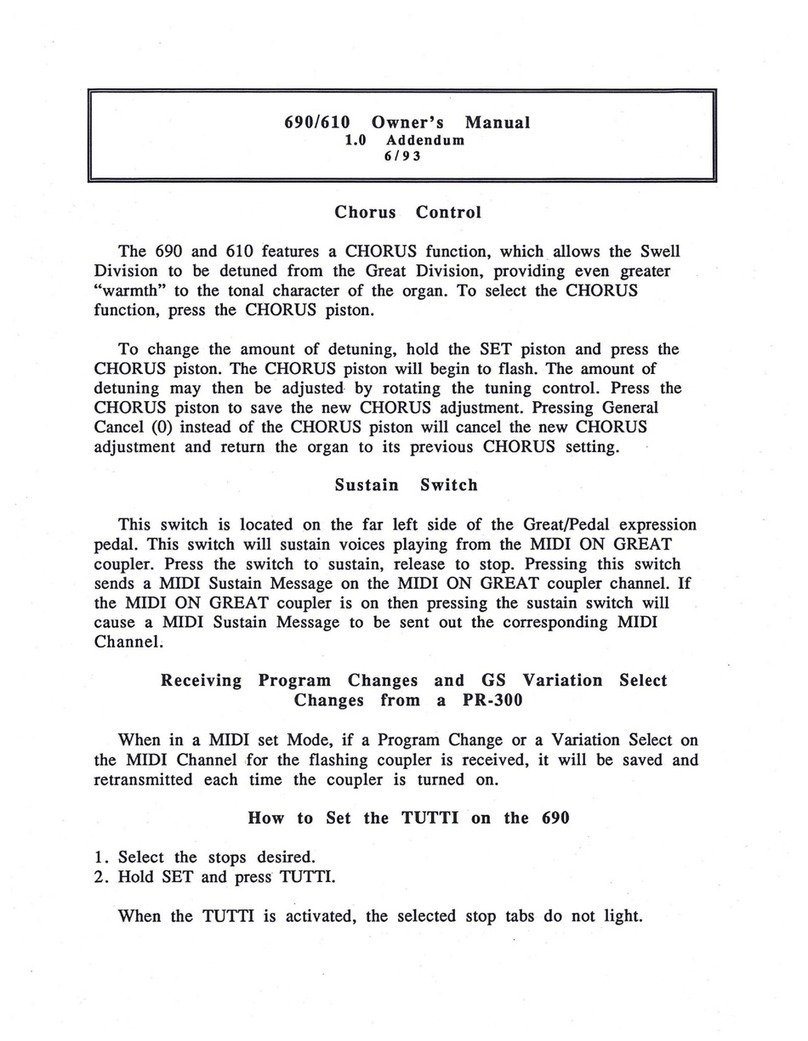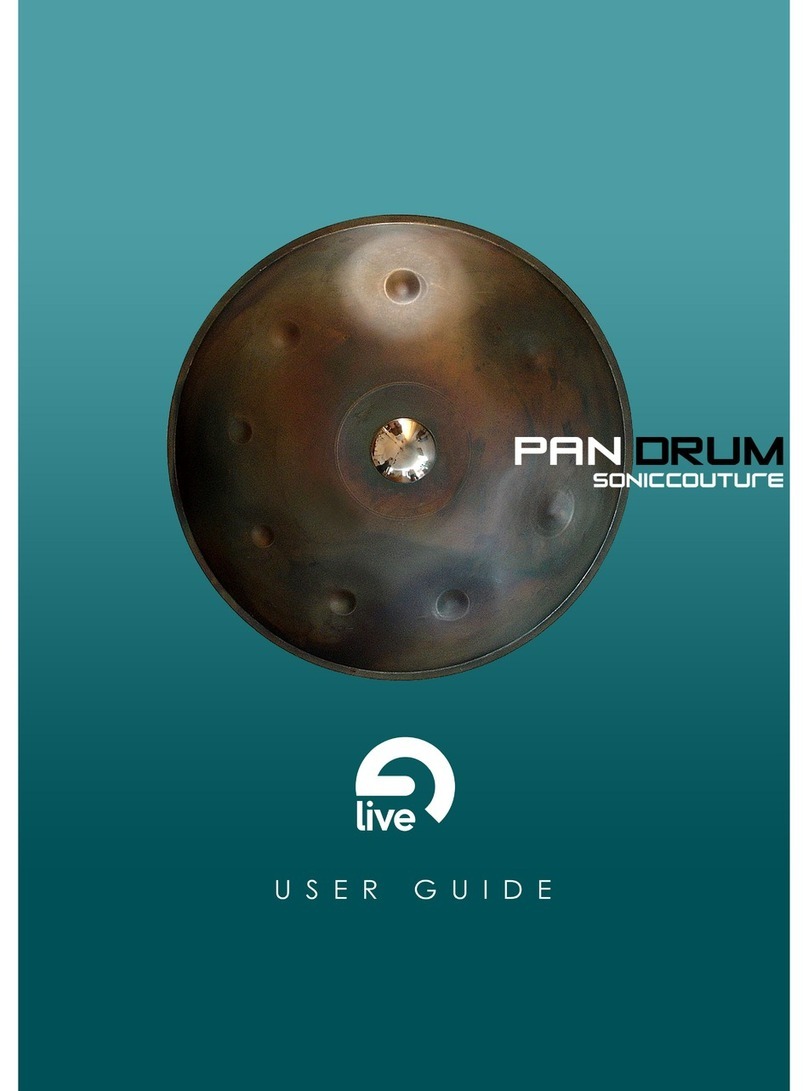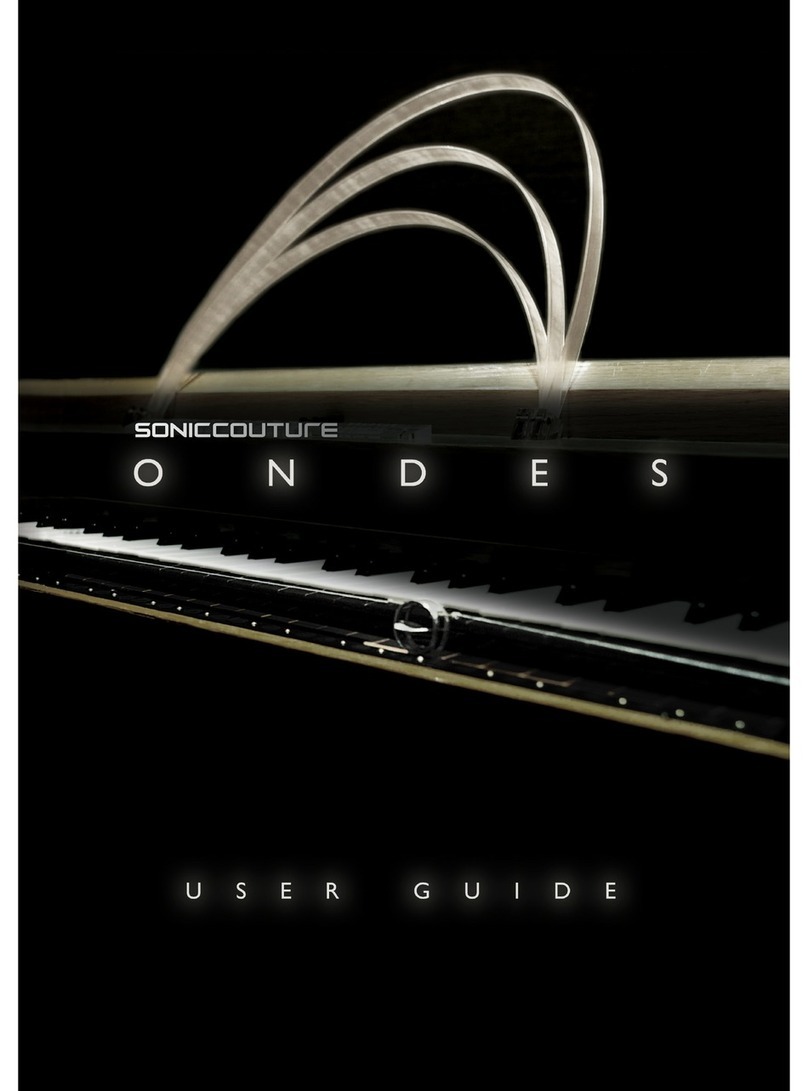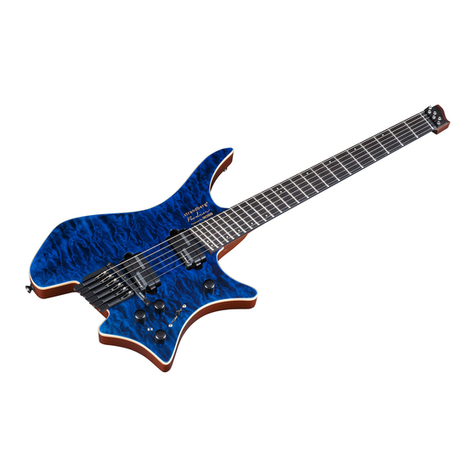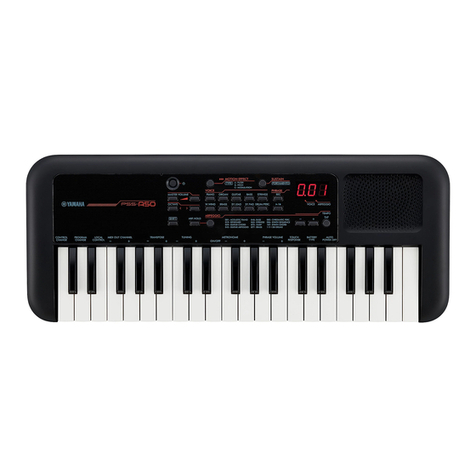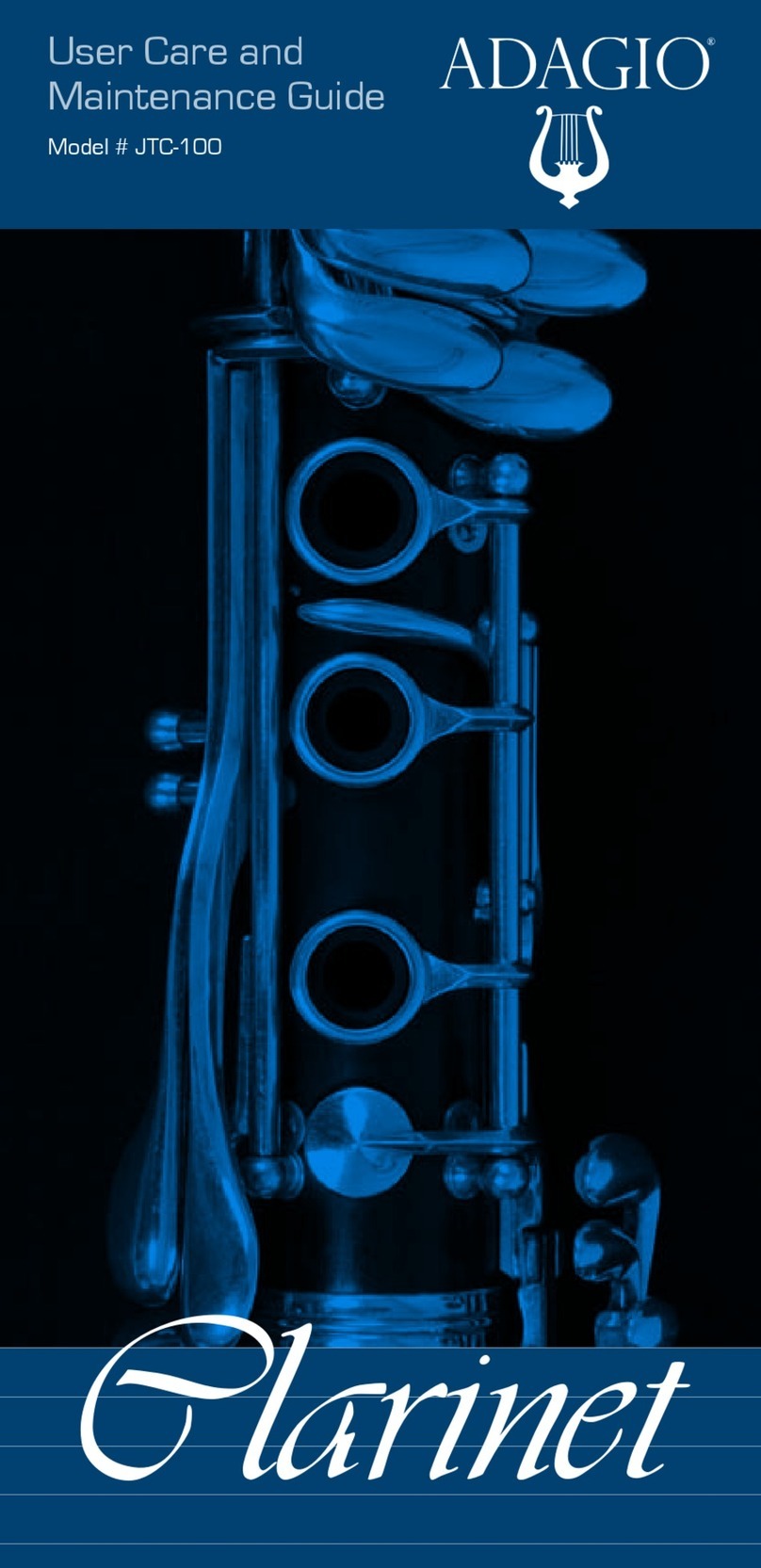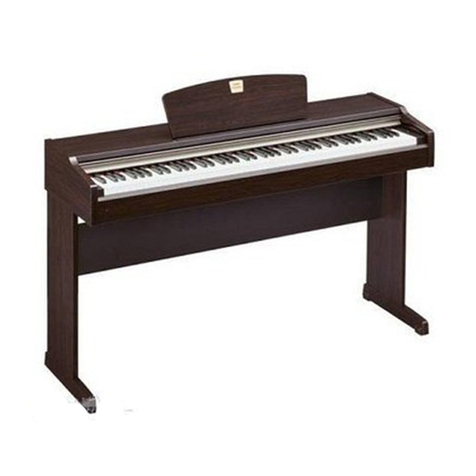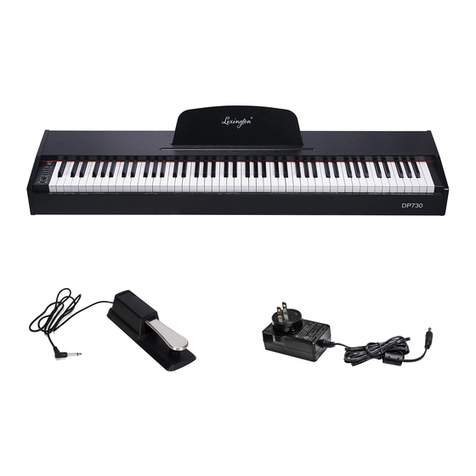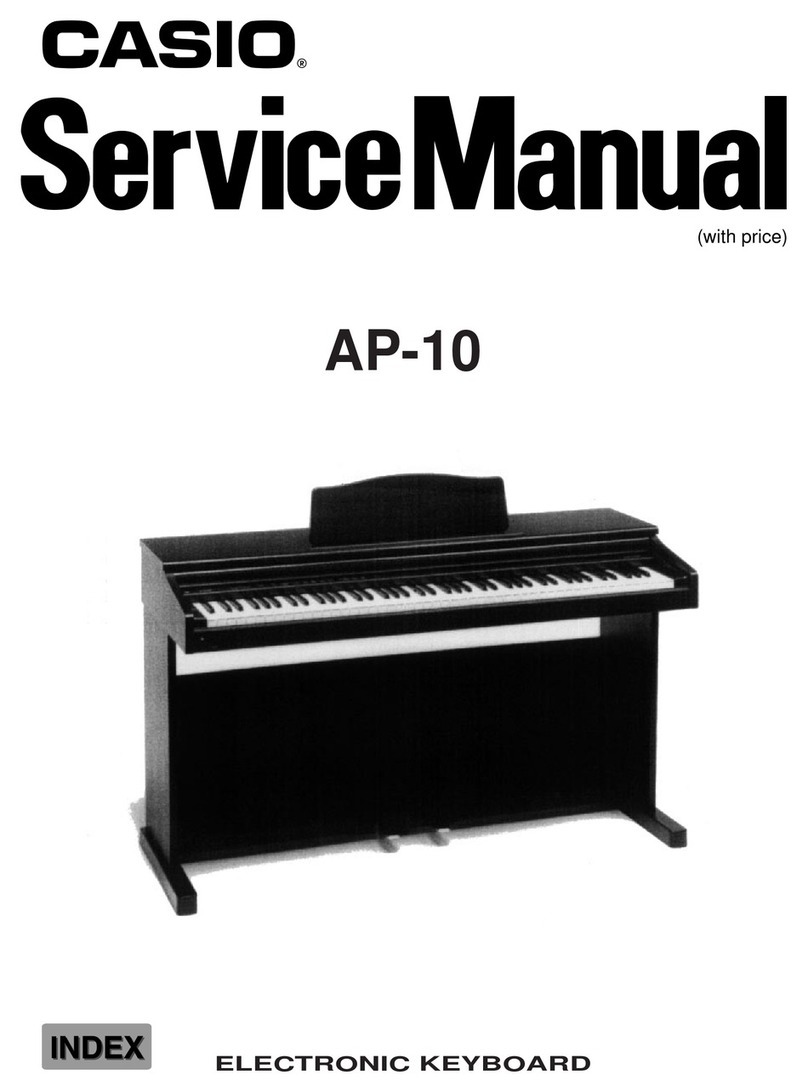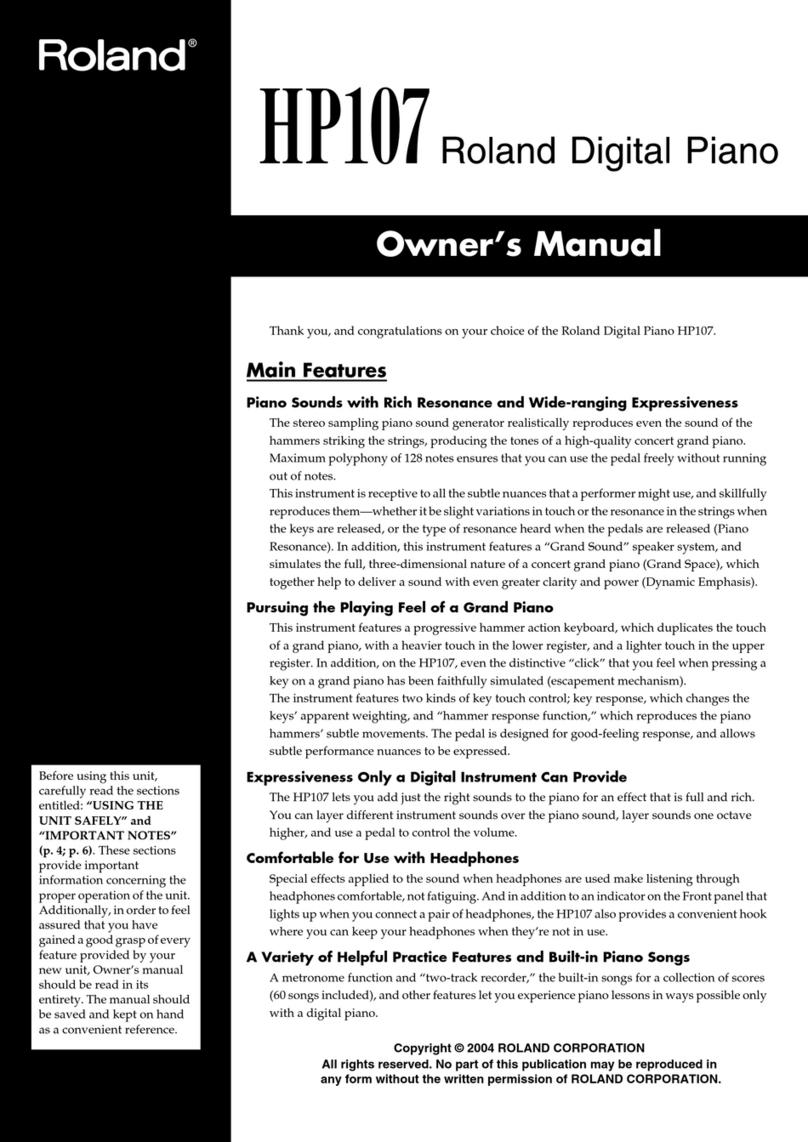StewMac UKULELE KIT User manual

Sheet #i-5371 Updated 11/18
Assembly
Instructions
StewMac
UKULELE KIT
PREMIUM SOLID-WOOD

stewmac.com
2
Tools and supplies..................................... 2
Parts list .............................................. 3
Installing the rosette .................................. 4
Brace the top and back ................................ 5
Make the body mold .................................. 7
Assemble the body ................................... 8
Prepare the neck ......................................15
Level the frets .........................................21
These are the tools and supplies we recommend for assem-
bling this kit. StewMac item numbers are included where
applicable.
Tool you will need (required)
Clamps (few are needed, but more are handy)
4-6 Small cam clamps (#3721)
2 Small sound hole clamps (#2010)
20 Mini clamps (2 packs of #3712)
Flat mill le or pillar le (#4175)
Razor knife (#4878)
Small chisel (#1619)
Fine-cut saw (#3617)
Side cutter or fret cutter (#0619)
Hammer for fret installation (#4895)
Micro-Mesh Soft Touch Pads (#3730)
Electric hand drill
1/4" and 1/16" drill bits (#4850, #1710)
Scissors
Straightedge to reach from string nut to bridge (#3850)
Good quality rule accurate to 1/64" (#4905)
18" Rule
Optional tools
Go-bar Deck (#4731)
Laminate Trimmer (#0488)
Flush Trim Bearing + Router Bit (#1298-B, #1298-000)
Fret Beveling File (#3760)
Tools and supplies
Table of contents
Sand the body and neck ..............................22
Locate the bridge .....................................23
Apply the stain (optional) .............................25
Attach the neck .......................................26
Apply the nish .......................................27
Glue the bridge .......................................28
Install the tuners ......................................28
Fit the nut and saddle .................................29
Supplies
Titebond Original Wood Glue (#0620)
or StewMac Fish Glue (#0702)
StewMac #20 Medium Super Glue (#0020)
Masking tape or low-tack protective tape (#1683)
Double-stick tape (#1689)
Scraps of wood for various clamping cauls and supports
Waxed paper
For body mold:
3/4" plywood, 19"x12"
Four 2-1/2" steel corner braces with mounting screws
Eight large screw eyes or screw hooks
Sandpaper (#5562 or #5096)
60-grit, 80-grit, 120-grit, 220-grit, 320-grit, 400-grit
Sanding blocks (scrap wood or #3701, #3699)
ColorTone Wipe-On Poly Finish (#3622)
ColorTone Liquid Stain (optional)
Steel wool, 0000-gauge
Fretboard oil or lemon oil (#3863 or #3864)
Paste wax, such as car wax
Cotton balls
Scraps of t-shirt material

stewmac.com 3
Welcome to instrument making!
Whether you’re a rst time builder or an experienced
luthier, this kit is a great way to have fun and learn a lot.
This solid-wood ukulele kit will produce a professional
quality instrument you will be proud of for decades
to come. The design and construction is similar to an
acoustic guitar, but faster and easier to build.
Parts list
This kit can be assembled with basic tools, but we've
also shown how to use more specialized lutherie tools
in the construction of this ukulele.
When you’re done, you’ll have an excellent sounding
ukulele, and you'll have the necessary skills to start
building guitars!
Kit contents
Top
Back
Sides
Fully shaped neck
Slotted ebony fretboard
Tuners with mounting hardware
Carved, drilled bridge
Shaped saddle
Rosette puring
Fretwire
Two back braces
Six top braces
Shaped bridge plate
Lining
Neck block
Tail block
Rubber binding bands
Full-size bracing plan

stewmac.com
4
Before we dive into bracing the top of your ukulele we need
to install the rosette. Your top has come with a pre-routed
channel that the rosette will t perfectly into.
To get started locate the cream and black puring pieces.
Neatly arrange them in the following conguration: cream /
black / cream / black / cream. As you can see it’s challenging
to align them all neatly, they have a tendency to slide around.
To help hold them It is helpful to use a tight piece of masking
tape on the end to help keep everything in place.
Once you have them arranged place them in the rosette
channel.
Using a razor blade or your fret cutters trim the ends of the
rosette. It’s not absolutely necessary that the puring pieces
make a perfect join. The upper ring of the rosette will be
hidden under the ngerboard extension.
Next remove half the rosette.
Flood the channel with glue (Titebond Original Wood Glue
works very well for this application).
Now take your nger and guide the purings back into the
glue lled channel. The glue acts as a lubricant and every-
thing should slide back in place very easily. (Don’t worry
about the mess, we will clean that up in a second.)
Now remove the purings from the unglued side and repeat
the process. Be sure you remove enough of the puring so
the entire rosette is glued into the channel.
Now we will clean up all the excess glue from the top of the
instrument and any that may have got through the sound-
hole on the inside of the top. (It’s a good idea to wipe up any
glue that may have got on your workbench as well.)
Now place a sheet of wax paper on your workbench under
the top, and one over top the wet glue on your rosette and
weight it down with something heavy to dry – a spare 10lb
plate does the job nicely, but a heavy book would work
equally well.
Let this dry for 2 hours.
After 2 hours, remove the weight and use a sanding block
with 120-grit adhesive sandpaper to sand the rosette ush
with the top. Be sure to sand in a wide area so you don’t
accidentally make the top thinner in this area.
Installing the rosette

stewmac.com 5
Apply the glue
For this application we recommend using Titebond Original
Wood Glue or StewMac Fish Glue.
Apply a thin bead of glue to the brace and use your pinky
nger to spread an even, thin, lm of glue across the entire
brace. Quickly wipe your hands with a dry cloth and seat the
brace in the proper location.
Start by placing a clamp (or Go-bar) in the center of the
brace. Parts tend to skate around during clamp up, so it is
always a good idea to ensure your brace hasn’t moved from
its intended location. If you are using clamps, lightly snug it
up once your brace is in place.
Now place a Go-bar or clamp at each end of the brace. (Again,
frequently check to ensure your brace hasn’t moved during
clamp up.)
If you’re using clamps, 3 will usually suce for a ukulele, but
if you like feel free to add a couple more for added assurance.
Snug them all up. It doesn’t take a lot of clamping pressure
so there is no need to over tighten your clamps.
If you’re using Go-bars feel free to place 2 more bars on the
brace for added clamping pressure.
Wait 5 minutes and clean up the squeeze out. (Waiting a
few minutes gives the glue a bit of time to gel which makes
clean up easier.)
One extremely eective way to clean up squeeze out is
to use a scrap piece of spruce that has been sanded into a
crude “chisel” blade. The soft wood doesn’t dent your brace
or leave marks yet cleans up the glue quite nicely. Any re-
maining glue residue can be wiped away with a damp (NOT
wet) cloth rag.
Ensure your brace is seated tightly to the back across the
entire length.
Let it dry for 2 hours.
Begin by carefully cutting out the plan on or just outside
the solid black line that denotes the sides. This can be done
with scissors or a razor knife.
Transfer the brace plan to the wood
Mark a centerline precisely on your back plate along the
center seam.
Tape your plan carefully to your back plate taking care to
ensure the centerlines match perfectly at both ends.
Locate the back braces by using a pushpin, awl or scribe
to poke small holes into the wood at the brace ends. The
back braces are the two horizontal braces at the waist and
lower bout.
Connect these holes with a pencil and straightedge, which
will be your marks for where to glue the braces.
Save the plan drawing for use later throughout the build
process.
Gluing the back braces
Notice that the bottom of your back braces have a radius.
This adds structural integrity to your instrument as well as
improves the sound quality.
You can glue each brace separately, or use a Go-bar Deck
and a radius dish to clamp more than one brace at a time.
Do a dry run before gluing
It is always a good idea to test your clamping setup before
you apply glue. Decide where to place clamps and cauls on
your bench, and frequently check to see that the braces are
located in the proper location and held down tightly from
end to end.
You don’t want to gure this out while the glue is drying!
The important thing is that you’re comfortable with your
clamping plan, and have seen that it works before you’re
under the time pressure created by wet glue.
Brace the top and back

stewmac.com
6
We recommend starting with the bridge plate rst, followed
by the fan braces.
If you are using a Go-bar Deck you can probably glue all 3 of
the fan braces in place in one session, if you are using clamps
it may be better to take them one at a time.
Take your time. There is no rush.
Apply the glue
Let’s start with the bridge plate. Put a small dab of glue in
the center and use your pinky to spread an even, thin lm all
the way to the edge. Wipe up any excess glue on your hands
and glue that may have run over the edges of your plate.
Precisely locate the bridge plate and apply a clamp or Go-bar
to the center. After the clamp is applied carefully recheck
the position of the plate and apply additional clamps (or
Go-bars).
Ensure the bridge plate is seated tightly to the top all the
way around. After 5 minutes clean up the squeeze out. Wait
2 hours and remove the clamps.
Now it’s time glue in the fan braces. The center fan brace
has a notch for the bridge plate. Locate this brace directly
on the centerline. Apply glue and lightly clamp it in place.
The two outer fan braces should bump up to the right and
left side of the bridge plate. To get the best tone from your
instrument is important that the fan braces are all making
contact with the bridge plate.
Glue them all in place using the same method we have been
using and clean up any squeeze out.
Let them dry for 2 hours and then remove the clamps.
If you are using a Go-bar Deck feel free to go ahead and glue
up the other brace in the same manner now. If you’re using
clamps it’s best to wait and install the braces one at a time.
Bracing the top
We are going to begin by locating the position of the top
braces similar to the approach we used on the back.
Mark a centerline precisely on the center seam inside your
top. (While you had a choice of which side was the exterior
on the back of your ukulele, the top has been predetermined
since the rosette will be on the face of the instrument.)
Tape your plan carefully to the interior of your top plate
taking care to ensure the centerlines match perfectly at both
ends, and the soundhole aligns with the drawing.
Locate the upper and mid transverse braces with a pushpin,
awl or scribe. These are the long horizontal braces just above
and below the sound hole.
Note: The mid transverse brace resides in the same
location as one of your back braces, so don't let this
confuse you.
Connect these holes with a pencil and straightedge, and you
have the brace locations marked for gluing.
Now carefully mark the locations of the bridge plate and 3
vertical fan braces. Once this is done lightly draw the loca-
tions of all the braces for your top.
Remove the plan. We will be using it again shortly.
Gluing the top braces
As with the back braces you can glue each brace separately
with clamps, or use a Go-bar Deck and a radius dish to clamp
more than one brace at a time.
However, unlike your back braces which had a slight radius,
you’ll notice the top braces are at. This means that if you’re
using a Go-bar Deck you’ll want to make sure to remove the
radius dish and replace it with a at surface (or ip the radius
over and use its at back.)
Do a dry run before gluing
Getting the brace locations exactly right on the top is criti-
cally important to the structural integrity and tone of your
instrument. So like you did when gluing the back braces,
take a few minutes and do a dry run of your clamping setup
before you apply glue.

stewmac.com 7
in the photo (below). Screw these two braces to the plywood,
on the centerline. Position them so they are against the bold
line of the uke shape. These are clamp supports for gluing
the neck block and tail block to the sides.
These clamping blocks should be no taller than the sides
of the ukulele.
The other two corner braces support the sides at the uke’s
waist. To avoid metal scarring the mahogany sides, give
these brackets some padding. A piece of dowel wrapped
in masking tape works well.
Screw these braces to the plywood, positioning them against
the uke outline at the waist.
Now we’re ready to begin working on the body.Next glue in the lower transverse brace followed by the
upper transverse brace.
Let the braces dry for 2 hours before removing the clamps.
Make the body mold
Now we are going to turn our attention to the ukulele body,
and this begins with creating an outside mold.
This is a very simple xture: a piece of plywood (or MDF) and
four 2-1/2" corner braces (angle brackets). It holds the body
pieces in shape while you build.
Start with a high quality piece of 3/4" plywood (or MDF),
19"x12". Draw a centerline down the middle of the board.
Tape or spray mount the plan drawing to the plywood,
aligning it on the centerline. The bold black line on the plan
drawing is the nal shape of your uke.
Attach blocks of wood to two of the corner braces, as shown
Optional: showing the gluing setup with clamps.

stewmac.com
8
extension toward the back of
the instrument.
Carefully measure and mark
a centerline on both blocks.
The neck and tail blocks need
to be the same height as the
sides. If yours are taller than
the sides, trim them with a
saw or chisel. This is easier to
do now than later.
Glue the sides and blocks
You can glue the blocks in using the mold as support, or
out of the mold. Each method has pros and cons. Using the
mold provides rigidity, however, clamping up outside the
mold allows the visibility to ensure everything is aligned
perfectly during glue up.
For these instructions, we are going to glue up the tail block
outside the mold, and the neck block inside the mold.
Assemble the body
Place the bent sides into the body mold, with their ends
butted together at the center. Now you can see the body
of your ukulele taking shape!
If the sides are oversized and extend more than 1/8" past
the centerline when you insert them in the mold they will
need to be trimmed.
To do this, while holding the sides down rmly in the mold,
and ensuring they line up nicely with picture of the sides
axed to your work board, carefully mark the centerline
on your side near the headblock. Remove the side, mark a
square line and carefully cut this with a saw. (A little double
stick tape and a wood block provide a good fence to ensure
your cut is square and straight.)
Reinstall the side in the mold. Align the newly trimmed side
to the centerline at the neck block, hold the sides down to
the work board to ensure they line up with the prole on
your plan and mark the centerline at the tail block. Mark
and cut the side the same way you made the previous cut.
Repeat the process for the other side.
Now we are going to glue in the neck and end blocks.
Snap the sides into the mold so the neck and tail ends t
end-to-end perfectly. Align the seams to the centerlines
marked on your plan.
If the sides don’t precisely match the body shape on the
plan drawing, don’t worry. A little variation between ukes
is ne. As long as the side curves match each other nicely,
you’ll have a great looking instrument.
The corner braces will hold your sides nicely square to the
baseboard, so the body doesn’t “lean” in one direction. If
you like, use a square to double-check this.
The tail block is the smaller of the two blocks, and the neck
block has horizontal extensions on both ends.
When gluing in the neck block, place the “square” horizontal
extension toward the top of the ukulele and the “rounded”

stewmac.com 9
When you’re comfortable with your clamping setup, put
glue on the neck and tail blocks.
Put a little glue on the narrow edges of the sides that butt
together, too. If the neck and tail blocks quickly absorb the
glue, add more to make sure you have a slightly wet gluing
surface. You don’t want a glue-starved joint.
Clamp the blocks and sides, and let them dry for 1-2 hours.
Use warm water to clean up any glue squeeze out. Titebond
and Fish Glue cleans up nicely after 10 - 15 minutes. It is still
wet enough to remove, but rubbery enough to make clean
up less messy.
Install the linings
The exible wooden linings will be glued to the edges of the
sides, ush with the top and back. These strengthen the body
and provide a wider surface for gluing the top and back.
For rm gap-free pressure all along the linings, you’ll need at
least 12 Mini Clamps for Linings to glue one lining strip. Using
even more, closely spaced together, ensures that the linings
are pressed to the sides at every point along the curves.
The linings are oversized and will need to be trimmed before
glue up.
The easiest way to do this is to carefully install a piece of blue
painters tape ush with the top edge of the ukulele’s side.
Take your time to ensure the tape aligns perfectly with the
top edge of the side. Carefully trim the tape exactly where
it meets the neck block and the tail block. Before removing
the tape, place a visible mark at the apex of the waist.
Remove the tape and align the mark on the tape to the apex
of the waist on your pre-bent lining. Carefully align the tape
to the top edge of your lining.
At the end of the tape make a pencil line.
Technically, the pencil line at the ends of the tape should give
you a perfect t. However, due to small errors in alignment of
the tape when measuring the sides, and when tting them
to the linings if you cut to the pencil lines the linings will be
a smidge too short.
To account for this make a mark 1/16" past the trim line at
the ends of the tape, draw a square line and cut the lining
at these locations.

stewmac.com
10
Do a dry run of the clamp up before applying glue. Fit the
ends of the linings against the neck and tail blocks. Starting
at the neck block apply clamps closely working toward the
tail block.
Once all the clamps are in inspect the rim carefully to ensure
the linings are tight to the sides. If there are no gaps you’re
ready to glue!
Apply glue to the linings and clamp them. Wait 10 minutes
and clean up any squeeze out by gently scraping it away
with a razor blade. Any remaining glue marks can be gently
scrubbed o with a damp (not wet) cotton rag.
If you have enough clamps you can glue up both halves
of the rim at once. Allow them to dry for 1-2 hours before
removing the clamps, then turn the sides over in the body
mold and glue the linings to the other edge.
Sand the linings ush
The edges of the sides need to be smooth and uniform for
gluing the top and back. The easiest way to do this is with
adhesive sandpaper taped down to a at surface (such as
a piece of MDF).
Remove the rim from the mold and draw a pencil mark across
the face of the blocks and linings. Lightly rotate the rim on
the sandpaper until the lines disappear.

stewmac.com 11
Sand each brace with 80-grit, 120-grit, and 220-grit and try
to create an even, uniform, attractive looking brace.
Fit the back to the sides
The braces on the back are intentionally longer than the
width of the body. When you place the back on, these braces
will overhang the sides.
The next step is trimming braces to length, and creating
notches in the side linings so the back drops in place.
Place the back in position, aligning it on center. Use a weight
to hold it in place. Make small pencil marks on the sides to
show where the braces touch. Extend these marks over the
edge of the sides and linings.
Shaping the Braces
After the glue has dried at least 2 hours, and all the clamps
have been removed lightly shape the top and back braces.
Using a small block of wood with adhesive sandpaper at-
tached lightly round over the top of each brace.
(To keep your work clean and neat, and to protect the top
and back plates of your instrument it is helpful to put down
protective layers of tape. Simply take regular duct tape or
masking tape and stick it to your shirt a few times to remove
some of the stickiness and apply it right next to your brace.)
Once the top of your brace has been roughly shaped with
the sanding block use a piece of sandpaper between your
ngers to round over the top of the brace.

stewmac.com
12
With a sharp razor knife, cut notches in the linings for the
braces. A small chisel is helpful for chipping out the notch.
Trim the ends of the braces so they t within the sides,
dropping into the notches. Scrape the trimmed brace ends
o the back. When you’re done, the back ts at onto the
sides, with the braces keyed into the notches.
The top and back are slightly oversize, with edges that hang
over the sides. This overhang will be removed after gluing.
Glue the back on the rim
To get good clamping pressure all around the back, the
body mold is now put to use again. By adding screw eyes
or hooks around the edges of the of the plywood, you can
ax the rubber clamping bands included with your kit. If
your clamping band is an unbroken loop, cut it to make it
one long strip.
Tie the end of the clamping band and stretch it tightly over
the body to the opposite corner. Continue strapping from
corner to corner until the back is clamped under a web of
rubber bands. Tie o the end to one of the screw eyes. Try
this as a dry run.
When you’re ready for glue, apply it to the edge of the side
and lining, and to the end of the neck and tail blocks. Put the
back in position and wrap with the rubber clamping band.
Let the glue dry for 2 hours, then remove the body from
the mold. Clean away any dripped glue, especially where it
can be seen through the soundhole of the assembled body.

stewmac.com 13
Trim the overhang
Before you glue the top on, you will need to trim the over-
hang on the back of your ukulele. This involves cutting the
overhang slightly proud of the sides, then sanding away
the remainder to make the edges smooth and ush with
the sides.
A Dremel rotary tool with StewMac’s Precision Router Base
and Edge Guide is ideal for trimming the overhang. Use a
down-cut router bit to make a clean cut. Rout away most
of the overhang, leaving it small enough to remove with
sandpaper.
You can also trim the overhang with a sharp razor knife and
a at le. Using the knife, carve away a small bit of wood
with each cut, reducing the overhang until it is close to the
sides. Follow with the le to bring it close enough to remove
with sandpaper.
Beware of tear out. Whether you use a router or a knife, you
must pay attention to the grain of the wood on the body
curves.
At the curves, a cutting tool working against the grain wants
to dig into the wood. This action makes it easy to tear out
a chunk of wood.
To avoid tear out, plan your cuts so that the router or knife
approaches each curve on its downward slope, rather than
climbing upward. The eight arrows on the illustration show
the direction to make each cut around the body.
After trimming, the remaining back and top overhang should
be very small. You’ll remove this with a le and sandpaper.
To avoid tearout,
make your cuts
on the downward
slope of the curve,
with the grain.
Don’t cut upward
against the grain.
Cutting tool
approaching
a curve from
this direction
invites tearout.
Tearout: accidentally breaking at the grain line
Tearout: the
wood breaks
at the grain.
Cutting from
the opposite
direction makes
tearout much
less likely.

stewmac.com
14
Don’t sand the sides at this point. That comes later. Just make
the top and back edges ush with the sides.
Sand until you have a smooth edge all around the uke.
Glue the top on the rim
Now we will t the top and glue it on.
Reinsert your body back in the mold with the freshly glued
on back facing down. Align the centerline with the marks
you placed on your end blocks.
Just like with the back braces, we will need to trim and t
the horizontal transverse braces. Perform the same steps
you did for the back braces - trim them to length, and create
notches in the linings so the top drops in place.
It’s very important during this step that the centerline of the
top remains on center with the rim. Take your time while
notching the braces and gluing up to make sure everything
is in the proper location.
Use the same clamping procedure to install the top. Wait
at least 2 hours and remove it from the mold and trim the
overhang like you did on the back.
Sand the top and back ush with the sides
A at le will remove the remaining bit of overhang, followed
by sandpaper to make a smooth, ush edge.
Put masking tape on the sides to protect them from le
marks. Carefully file away the overhang until it’s small
enough that you feel ready to switch to sandpaper. You
might not need the le at all: 120-grit sandpaper may be
all you need.
With a at sanding block, follow the outer curves of the body
to ush the edges with the sides. A curved sanding block or
a stout wooden dowel makes a good sanding block for the
inside curves at the waist.

stewmac.com 15
Prepare the neck
Install the side dots
The position markers on the side of the ngerboard are
made from a small plastic dowel, 1/16" in diameter. The dots
are centered between the same frets that have inlaid dots
on the board.
Use your scribe, awl or pushpin to mark holes for drilling.
Make sure all the holes are centered equally down the side
of the board. You might want to put two dots at the 12th fret
to indicate the octave; this is optional on a ukulele.
Using a drill with a 1/16" bit, start each hole by briey run-
ning the drill in reverse. This will create an indentation in the
wood to center the bit so it doesn’t wander when drilling.
Hold the drill square to the surface, and drill each hole about
1/8" deep.
Turn the end of the side dot dowel against a piece of sand-
paper to clean up the end so it will slide into the hole. Then
dip it in Titebond glue and insert it in the hole.
Wipe away any excess glue, then cut the dowel o at the
surface of the wood using fret cutters or side cutters. After
installing all the dots, use a le to level them ush with
the surface of the wood. The result is a line of small round
position markers.
Preparing for fretting
Use a smooth flat work surface. You want a solid table
that won’t bounce or shake when you tap the frets with a
hammer.
Lay the end of the wire over the rst fret slot, so it protrudes
only very slightly over the edge of the board. Holding the
wire down with one hand, cut the fret at the other side of
the board. This creates a fret that’s cut to length for this slot,
with very little extra metal to le away from the ends later.
Use a fret cutter or side cutter to cut the fretwire.
Set the cut fret aside and move on to the next. Fasten a piece
of masking tape to your table, sticky side up, to keep your
cut frets in order while you work.
Install the frets
The top of the fret is called the crown. The strip that ts into
the fret slot is called the tang. Position the rst fret so the
tang sits on the fret slot. Hold the fret in position by pressing
it down at the center with one nger. With a hammer in your
other hand, tap the two ends of the fret into the slot.
When the ends are seated in the slot, you can remove your
nger and tap down the center of the fret. Do this for each
fret down the board.
Any hammer can be used, but a small one, like a fretting
hammer, works best. Don’t hit the fret or the board hard
enough to cause dents.
Glue the frets
Adding medium viscosity superglue under the frets, such as
StewMac #20, keeps the frets seated.
Turn the board on its side and run the glue under the fret
slots. A small whip tip on the glue bottle will help direct the
glue into the fret slot.
After adding glue to each slot, turn the board over and do
the same to the other side.

stewmac.com
16
File the fret ends
Clamp the fretted ngerboard onto a piece of wood with
one edge overhanging. This is a convenient way to le the
fret ends. Use cauls to prevent the clamps from damaging
the ngerboard.
Using long strokes with a at le, remove the ends of the
frets so they are ush with the ngerboard edge.
A two-handed grip is recommended: it takes rm pressure
to le down the fret ends—especially at rst, while their cut
ends are sharp and uneven.
When you’ve made the fret ends ush, tip your le and give
a slight bevel to the fret crowns. This makes the frets more
comfortable to play. When the fret ends on one side are
smooth, rotate the board and perform the same procedure
to the other side. (Optionally you can use a Fret Beveling
le – #3760 – to get a perfectly uniform bevel on both sides
of your ngerboard.)

stewmac.com 17
Pre-t the neck
Now is a good time to pre-t the neck. Let’s start by carefully
drawing a centerline down the face of the neck (where the
ngerboard will be placed), and extend this line through
the underside of the heel (the part of the neck that makes
contact with the body).
Carefully extend a pencil mark on the heel so you can re-
draw a centerline to the underside of the heel as necessary.
Gently set the neck in position so the centerline on the neck
closely aligns with the centerlines on the front and back of
the body. Lightly mark the shape of the heel on the body
of the instrument.
Now take a rule or straightedge and check to make sure the
sides are perfectly at along the lines you just drew. If they
aren’t at use a sanding block axed with 120-grit sand
paper and lightly sand the entire surface of the side (with
the grain) until the area where the neck meets the body is
dead at.
Now, ax 80-grit adhesive sandpaper to the body of the
instrument and trim o any overhang with an exacto knife
or razor blade.
Gently sand the underside of the neck prole on the body
taking care to keep the centerlines on the body and neck
aligned. (This isn’t as hard as it sounds.)
When the bottom of the neck is fully sanded and the cheeks
of your neck set ush against the sandpaper your neck has
been roughed in and this will allow it to quickly be ne-tuned
later just before gluing.

stewmac.com
18
Drill the neck joint
Now let’s drill the holes for the neck location.
The neck has two 1/4" diameter holes for the dowels that
support the neck joint. You need to drill matching holes in
the body to t these dowels.
Measure from the top of the neck to nd the center of the
two dowel holes. Use these measurements to mark and drill
matching holes on the body.
After measuring the locations the pins carefully mark them
with a pencil and make a deep indentation with a scribe, awl
or push pin. This will help keep the drill bit aligned when
you drill the hole.
Note: It is possible that the locating holes may not align
with the centerline on the body due to small dierences
in where the holes are drilled on the neck.
Drill the two holes using a 1/4" drill bit. To keep the drill from
skating around as you begin drilling the hole, start the drill
in reverse until it makes an indentation that will help keep
the drill positioned.
Drill them 3/8" deep. (Mark your drill bit with a piece of mask-
ing tape to keep from drilling the holes too deep.)
Attach the ngerboard
The nut should seat rmly between the pre-attached head-
plate and the ngerboard.
Measure the hole
locations on the
neck and duplicate
them on the body

stewmac.com 19
Insert the fret board position marker material in the hole you
just drilled and snip it o with 1/8"–3/32" protruding above
the ngerboard. (It’s not necessary to glue the material in if
it ts snugly in the hole.)
Now repeat the process between the 10th and 11th fret.
When this is completed carefully align centerlines you made
on the ngerboard with the centerlines drawn on the neck
and rmly squeeze the ngerboard onto the neck. (Remem-
ber to align it with the pencil mark you made for the nut. It’s
a good idea to cover the pencil line with nger board. This
will ensure the nut ts nice and snug.)
The plastic ngerboard marker material will easily embed
into the softer mahogany. These will serve as registration
pins to help hold the neck in place during glue up.
It’s important that the ngerboard seats tightly on the neck.
Align the nut against the headplate and trace a pencil along
the face of the neck to determine the ngerboard location.
Carefully measure and mark a centerline on each end of
the ngerboard, and draw a centerline down the back of
the ngerboard.
You should already have a centerline drawn on the face of
the neck. Carefully mark the underside of the heel with a
pencil at the centerline location. This will help you ensure
the ngerboard is perfectly aligned on the neck.
Registration pins
It’s very important that the ngerboard is perfectly aligned
on center to the neck. As you may have experienced parts
tend to skate around during glue up.
To help with this we can optionally add 2 locating pins in
the ngerboard that will hold the ngerboard securely in
place during glue up.
You should have excess side dot material left over from an
earlier step where we added side position markers to the
ngerboard.
Using a 1/16" drill bit carefully drill a hole 1/16" deep in the
reverse side of the ngerboard between the 1st and 2nd
fret. You want to drill this hole about half way between the
centerline and the edge of the ngerboard.

stewmac.com
20
If there is any glue squeeze out in the nut slot or under the
ngerboard near the heel wait 5 minutes and clean it up
as you did with the braces. (Don’t worry about squeeze
out along the edges of the ngerboard. We’ll clean that up
after it is dry.)
Allow the glue to dry overnight.
Smooth the ngerboard/neck transition
The glue joint between the ngerboard and neck needs to
be smoothed to get a comfortable transition between the
rounded neck and the at edge of the ngerboard.
Use a at le and sandpaper to slightly round the ngerboard
edge, blending it into the neck. At this stage, you’re shaping,
not nal sanding. Final sanding comes later, as you prepare
for nishing.
While ling along the length of the neck, this is a good time
to double-check the bevel of your fret ends. When playing
the uke, you’ll appreciate the feel of the rounded neck
blending smoothly into the ngerboard, with comfortably
beveled fret ends.
Trim the heel
If the heel of your neck extends past the sides of the ukulele
we will need to trim the neck so the heel transitions nicely
from the back of the instrument.
If the registration pins hold the neck up (even the slightest
amount) use a le to lightly remove some material from the
registration pins until the ngerboard sits dead at against
the neck.
Preparing the nut area
If there is any dried glue squeeze out from where the head-
plate was applied it is easiest to remove it now before the
ngerboard is glued on.
It is easiest to remove this with a very sharp chisel. Simply
lay the back of the chisel along the face of the ngerboard
and gently remove any dried glue.
Gluing the ngerboard on the neck
Brush glue onto the surface of the neck, and press the n-
gerboard in place.
Wrap the board tightly with rubber binding bands. Even with
the registration pins it is important to check to be sure the
board is centered on the neck.
Table of contents
Other StewMac Musical Instrument manuals
